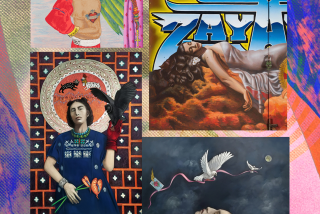SUSHI’S SCHUETTE ADEPT AT SHOWCASING BIZARRE
SAN DIEGO — Lynn Schuette, depending on your point of view, is a world-class snake oil huckster or an impresario of rare talent and vision. Either way she has accomplished the apparently impossible: developing an audience in San Diego for some of the most avant-garde performers in the nation.
Schuette operates what has to be theweirdest nonprofit business in conservative San Diego, presenting some of the most unconventional, innovative and bizarre entertainment oneis likely to see --anywhere-- but in a context of business as usual. And she has successfully done so for five years. At 37 Schuette is San Diego’s high priestess of performance art, a jambalaya mix of cutting-edge, vanguard, off-the-wall modern art.
Schuette is proud of Sushi’s success. Despite the rarefied environment of performance art, Sushi has always attracted an audience. Performance can be just about anything from a person inviting you into bed to talk about dreams, to a show involving piles of garbage that fill the floor, to a baldheaded woman expounding on the nature of sadism and masochism and asking audience members to put 3-inch fishhooks into her wrists, to such “new age” comics as Daryl Enriques--all of which have been seen at Sushi. Performance can be poignant. It can be hilarious. It can be terminally boring when it doesn’t work.
Boring the audience, or offending them, may be the biggest risk in running a performance art gallery. But so far, Schuette, who has fairly democratic tastes, has shown a canny knack for picking artists that entertain and challenge audiences.
The new Sushi season opens tonight with Los Angeles comedian Colin Gorman making his San Diego debut with an offering of what Schuette calls “new age” comedy. Gorman fits the rough pattern of such new age comedians as Philip Galas, a local performer known for his solo tirades, and Daryl Enriques, who played earlier this year for Sushi and its summer series in Del Mar. Enriques was “the funniest human being I’ve ever seen,” Schuette claims. “But you can’t put new age comedians in a place like the Comedy Store. They’re too off the wall.”
No performance artist herself, Schuette is founder, director and curator of Sushi, San Diego’s first and, so far, only performance art gallery, located at 852 8th Ave. A blonde who chain smokes Camel cigarettes, Schuette is Sushi’s major domo, chief cook and administrator. She shares her loft gallery with a pet Doberman pinscher named Eva and a roommate who is an actress.
Trained as a visual artist in Chicago, Schuette still paints--colorful abstract designs--but has made a reputation as an exceptional arts administrator in running Sushi. As a downtown resident, she takes an active role in promoting the revitalization of the center city, chairing a committee that judged public art mural designs for the Gaslamp Quarter several years ago. In January, Sushi will present five events in five lofts and other downtown spaces, a performance project which was to have been presented in the new Lyceum Theatre in Horton Plaza. But the theater’s opening has been pushed back to March. Schuette also is a member of a California Arts Council committee on interdisciplinary arts.
Each year she presents about 75 events at Sushi which draw about 60 people to each performance in the intimate 55-by-32-foot loft. There have been a number of memorable performances: Jo Harvey Allen’s character study of a truck stop waitress, actor-comedian Eric Bagosian whom Schuette describes as “the dark side of Whoopi Goldberg,” and the outlandish costume shows of Pat Olescko (“The Soiree of O, or Clothing as a Fecund Thought”). Others include the bilingual, surrealistic, multimedia, cross-cultural, controlled mayhem of Poyesis Genetica and the lyrical and plangent feminist pieces written and performed by Carla Kirkwood. Goldberg’s last San Diego appearance was at Sushi. Since gaining fame on Broadway, Goldberg has asked to be added to Sushi’s board of directors.
“She told me, ‘Put me on your board so I can give you money,’ ” Schuette said.
Schuette had a reasonably standard education, studying art history and traditional painting techniques, but ultimately migrating to art’s outer edge.
She hit college in the mid-’60s. While other art students were copying Impressionists, Schuette was being turned on by the Hairy Who, a group of Chicago artists doing “really very raunchy, aggressive, funky work.” What appealed to her more than the traditional was work that was immediate, that responded to the culture. “That was my group of people.” Sushi has been a way to keep in touch with the latest generation of those same people.
She designed Sushi to be run by herself, primarily on earned income. Unlike a program she once worked in, which was financed by federal Comprehensive Employment and Training Act grants, Schuette wanted people to pay for what she presented. “I said, if ticket sales won’t support it, then I won’t run the program more than a year.”
Instead of hyping the novelty of performance art, Schuette prefers to understate Sushi’s avant-garde tradition, but promotes the performers such as Tim Miller, a darling of the New York performance art scene. The result is that she has built a much more diverse audience than those which attend performance art elsewhere. In Los Angeles, San Francisco and New York, the performance artists tend to play to other artists. “People from New York come and look at our audiences and they’re amazed. They say, ‘You have normal people.’ ” In New York, Schuette said, performance art exists in a more incestuous environment. Artists joke about passing the same $5 around to see each other perform.
For the past two years, Schuette has employed an assistant. She chafes at what she sees as a tendency for San Diegans to support large cultural organizations. “There’s an inbred attitude that the larger the program, the better it is. The higher the budget, the better the quality. Large and small don’t have anything to do with quality or significance in a community. But that’s the way the thinking goes. If you give $1,000 to a large organization like the Globe, it doesn’t mean that much to them. Give it to a small program like Installation or Sushi or the Bowery Theatre and it’s a significant amount of money.” The California Arts Council grants that Sushi has received for the past three years, a recent $5,000 grant from a New York foundation and grants from the National Endowment for the Arts (NEA) tend to support her claims about small organizations having significance. But it bothers Schuette that she hasn’t been able to get a dime of local government support. Schuette has not applied for membership in COMBO, the local arts funding agency, because she feels that due to restrictions, the financial return would not meet the output in energy required to provide auction items for COMBO.
She is livid that COMBO granted only $500 of a $2,000 request. “I consider it highly unethical to say you are going to give grants up to $3,000, and not give a grant higher than $1,500, which is what COMBO did.” The $500 amounts to a quarter of the amount Sushi requested to finance a January project designed to double the audience size. “We already had another $2,000 from an NEA grant.” She is hopeful that the growing stature of the city’s Public Arts Advisory Board will improve local government financing of small arts groups.
In the meantime, she is shooting for new audiences. Next month Sushi is sponsoring a reception featuring a performance by Cultural Odyssey, one of the most popular groups to appear there, for the residents of the new Marina redevelopment project condominiums.
“We’d like to make a connection with the young, up-and-coming people, the Yuppies. We want their patronage. We think we can sell them Sushi. It’s more sophisticated, young and lively, like they are.”
More to Read
The biggest entertainment stories
Get our big stories about Hollywood, film, television, music, arts, culture and more right in your inbox as soon as they publish.
You may occasionally receive promotional content from the Los Angeles Times.










